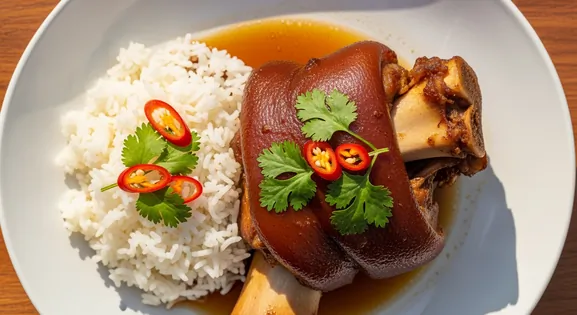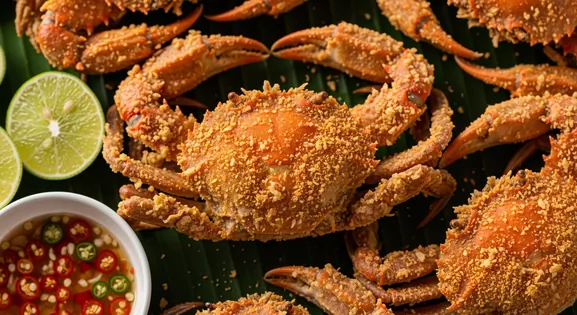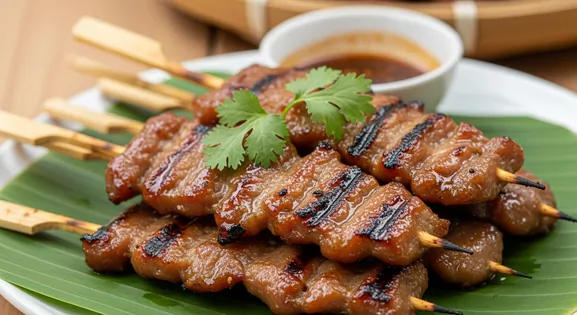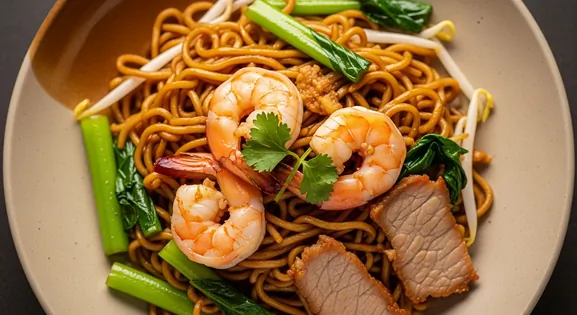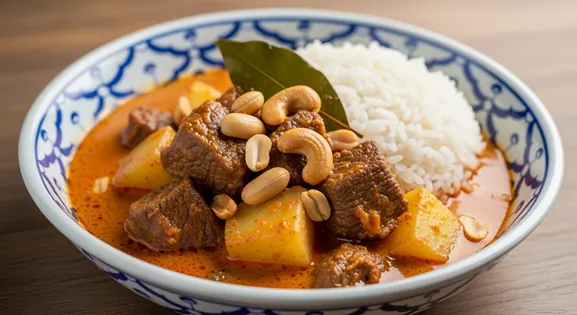Khanom Jeen (Fermented Rice Noodles) in Phuket
ขนมจีน
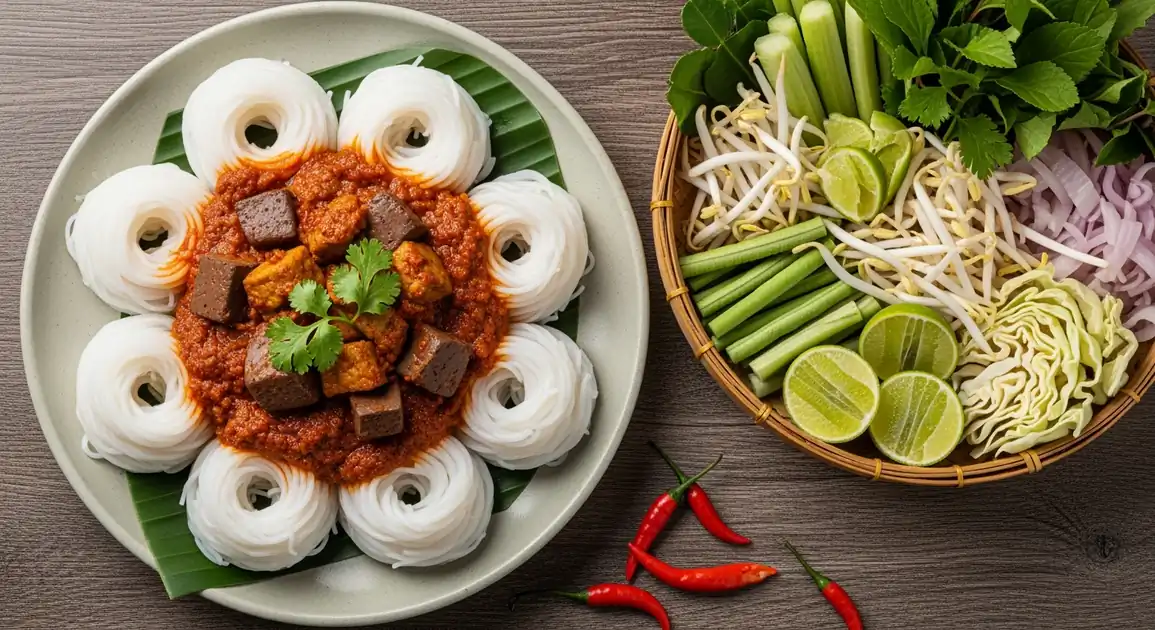
A Beloved Local Dish
Stepping into Phuket's morning markets, the aroma of spicy curries signals the island's beloved Khanom Jeen. This isn't just breakfast; it's a vibrant culinary journey, offering a taste of Southern Thailand's unique flavors and a glimpse into local life.
New to Khanom Jeen (Fermented Rice Noodles)? Learn all about its history in our complete guide.
What the Locals Know
While many curries are available, "Nam Ya Tai" (southern fish curry) is the quintessential Phuket Khanom Jeen experience. Look for its vibrant yellow hue and rich, aromatic flavor.
Phuket Khanom Jeen is served with an extensive array of fresh, raw vegetables and herbs. These are not just garnish; they are essential for balancing the intense spice and adding texture.
For adventurous eaters, "Gaeng Tai Pla" (fermented fish innards curry) is a local specialty. It's incredibly pungent and spicy, a true test of your palate, often found in local markets.
A Guide to Finding Khanom Jeen (Fermented Rice Noodles)
Phuket Old Town
Phuket Old Town is home to numerous authentic Khanom Jeen vendors, especially vibrant stalls found within and surrounding its bustling morning markets, offering traditional southern flavors.
Downtown Market, Limelight Avenue area, Thai Hua Museum vicinity
Early Morning, Mid-Morning
Patong/Karon/Kata
In popular tourist areas like Patong, Karon, and Kata, you'll find Khanom Jeen with slightly adapted spice levels, though the core southern Thai sauce profiles remain authentic and delicious.
Local food courts, Jungceylon area, Side street vendors
Mid-Morning, Lunch
Local Residential Areas
For a truly local experience, explore residential areas such as Kathu, where you can discover more authentic and traditional Khanom Jeen vendors frequented by Phuket residents.
Kathu Fresh Market, Local morning markets
Early Morning
Vendor Tips
- Ask for spice level adjustment if needed - southern Thai curries are notoriously spicy.
- Look for vendors who make their curry paste from scratch - they often have mortars visible.
- The freshest seafood additions are typically available in the early morning.
Authentic vs Imitation: The Telltale Signs
What to Look For
-
Vendors (often in morning markets or local eateries) keeping curry sauces ('Nam Ya Tai', 'Gaeng Tai Pla') actively simmering or steaming hot.
Southern curries often contain fish/seafood and coconut milk, requiring strict temperature control to prevent spoilage and bacterial growth in Phuket's heat.
-
Fresh, moist noodles in coils, usually covered.
Ensures noodle quality and protects from contamination.
-
Vibrant array of fresh Southern Thai vegetables, herbs, and sometimes fruits (like pineapple) or boiled eggs.
Freshness of the numerous accompaniments is key to the Phuket Khanom Jeen experience and indicates vendor quality.
-
Clean setup with separate ladles for each distinctively colored/textured Southern curry.
Prevents flavor mixing and cross-contamination.
What to avoid
-
Stalls with lukewarm or non-simmering curry sauces, especially later in the day.
Significant food safety risk due to potential bacterial growth in fish/coconut based sauces.
-
Noodles looking dry, sticky, or discolored.
Indicates lack of freshness.
-
Wilted, old, or limited selection of accompanying vegetables and herbs.
Detracts from the experience and suggests lower standards.
-
Uncovered sauces or noodle trays exposed to flies/dust, especially in open-air market settings.
Increases contamination risk.
A Guide to Price, Portions, and More
Dietary Information
Important Note for Travelers: Your safety is our priority. Below are the common allergens associated with the traditional preparation of this dish. However, recipes and ingredients can vary significantly between establishments. Always confirm all ingredients directly with the food vendor before ordering, especially if you have a severe allergy.
Potential Allergens
Dietary Suitability
Price Guide
Budget Tips
- Local markets in Phuket Town like Downtown Market offer the best value at 50-70 THB per plate.
- Tourist areas in Patong or Kata may charge 80-120 THB for essentially the same dish.
- Self-serve vegetables are often unlimited - take advantage to make a more filling meal.
- Some vendors offer smaller portions at reduced prices if you ask.
Serving & Seasonality
Phuket-style typically features Nam Ya Tai (southern curry) or other spicy sauces already ladled over the noodles. Served with an abundant array of fresh vegetables, including unique southern items like young banana flowers, coconut shoots, and wild ferns when available. Often accompanied by small dishes of extra condiments for customization.Best Times to Enjoy
- Early Morning: 6 AM - 9 AM at local markets for the freshest experience.
- Mid-Morning: 9 AM - 11 AM at specialty shops and restaurant-style venues.
- Lunch: 11 AM - 2 PM, more commonly available in tourist areas during this time.
Seasonal Availability
Available year-round with seasonal variations in accompanying vegetables and herbs during rainy season (May-October).
The Art of Ordering
Ordering Khanom Jeen in Phuket is straightforward. Point to your desired curry, and the vendor will ladle it over the noodles. Don't hesitate to ask for "mai phet" (not spicy) if you're sensitive to heat, though southern curries are inherently fiery. Locals often mix several curries on their plate for a complex flavor profile. Remember to help yourself to the communal basket of fresh vegetables, which are typically unlimited and crucial for balancing the rich, spicy flavors.
Unique Preparations of Khanom Jeen (Fermented Rice Noodles)
Khanom Jeen Pla Tu
A Phuket specialty featuring mackerel in the curry sauce, reflecting the island's fishing tradition.
Khanom Jeen Nam Ya Pu
Crab meat version especially popular in seafood-rich Phuket, sometimes including crab roe for richness.
Khanom Jeen Pak Tai
A robust southern-style version with intensely spicy curry, often containing multiple types of seafood and distinct southern herbs.
A Cultural Deep Dive
Local Significance
Khanom Jeen in Phuket represents the island's unique cultural blend of Thai, Chinese, and Malay influences, particularly evident in the intense, complex flavors of the curries paired with the noodles.
Eating Customs
- Southern Thais often add extra fish sauce, lime, and chili to already spicy curries.
- Fresh betel leaves sometimes serve as edible wraps for small bites of noodles.
- Some locals alternate bites with sips of cool herb drinks to balance the heat.
Mastering the Experience
Navigating the Spicy World of Phuket Khanom Jeen
How to choose and enjoy the intense flavors of Southern Thai fermented rice noodles.
- Identify the curry type: 'Nam Ya Tai' (yellow fish curry, common & spicy), 'Gaeng Tai Pla' (dark, pungent fermented fish innards curry, very spicy), 'Nam Prik' (sweet peanut sauce). Ask the vendor or look at color/ingredients.
- Start with a small amount of curry if unsure about spice level – Phuket curries can be very hot.
- Load up on the fresh vegetables, herbs, boiled eggs, and pickles provided – they help balance the intense flavors and heat.
- Look for unique Phuket additions like pineapple slices or local greens ('pak miang').
- Eat like a local: mix everything thoroughly on your plate before eating.
Finding Great Khanom Jeen for Breakfast in Phuket
Locate authentic Southern Thai noodle breakfasts on the island.
- Explore local morning markets in Phuket Town (e.g., Downtown Market) or areas like Chalong or Thalang between 6 AM - 10 AM.
- Look for dedicated Khanom Jeen shops or stalls, often identifiable by the large pots of colorful curries and extensive vegetable displays.
- Prioritize places bustling with local patrons having breakfast.
- Some local restaurants also specialize in Khanom Jeen throughout the day – ask for recommendations ('Ran Khanom Jeen arroi tee nai?').
- Be adventurous and try different curry types offered by the vendor.
Our Commitment to Quality
At Tasteplorers, our mission is to provide the most accurate and useful travel information in the world. To achieve this, all content on this site is created through our unique editorial framework. We utilize leading AI research tools, guided by our proprietary prompts, and a multi-stage validation process. This entire system is overseen by our editorial team to ensure everything we publish meets our high standards for accuracy, cultural nuance, and practical value for travelers.
Learn more about our Editorial Process and our Mission.
Countries
Explore regions
Europe
Discover Europe's diverse culinary landscape, from Mediterranean flavors to hearty Alpine fare. Learn to navigate markets, decode menus, and eat like a local.
Latin America & Caribbean
Discover the vibrant cuisines of Latin America & the Caribbean. Our expert guide covers everything from Mexican street food to Peruvian ceviche and market tips.
Oceania
Explore Oceania's diverse food scene. Learn about Polynesian earth ovens, Fijian feasts, and the vibrant café culture of Australia and New Zealand.
Southeast Asia
Explore Southeast Asia's diverse food cultures from Thailand to Vietnam. Get expert tips on navigating spice levels, choosing quality vendors, and understanding the rich traditions of the region.
